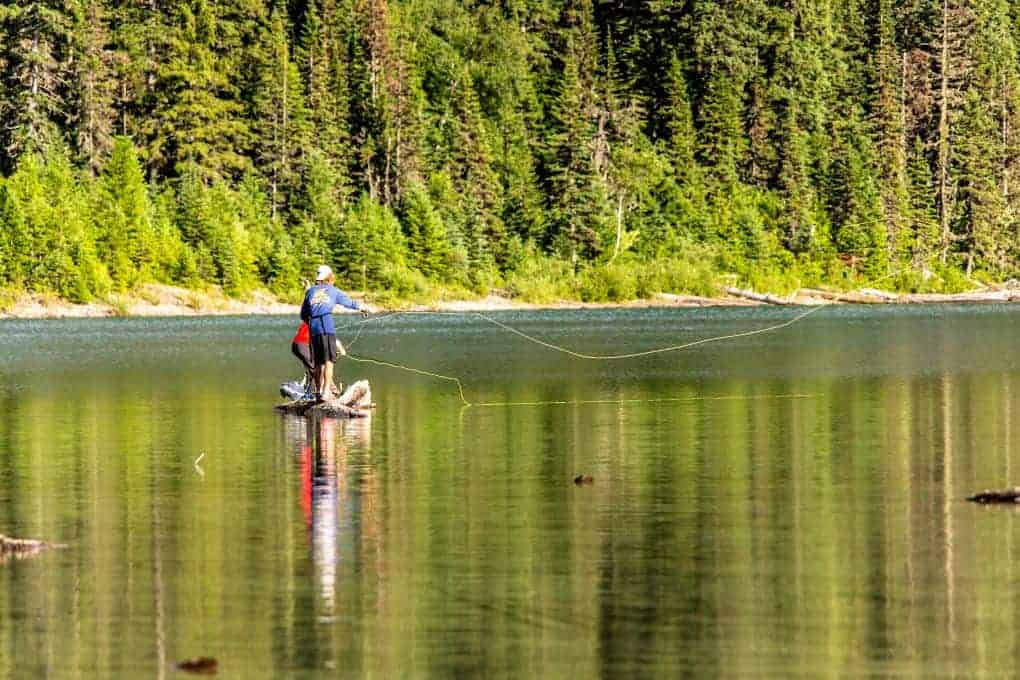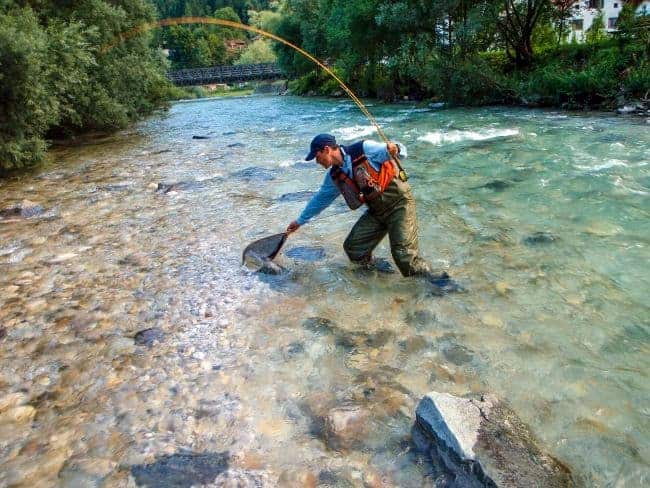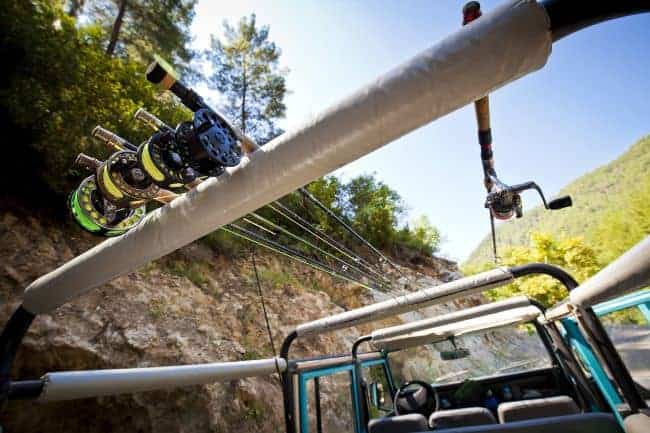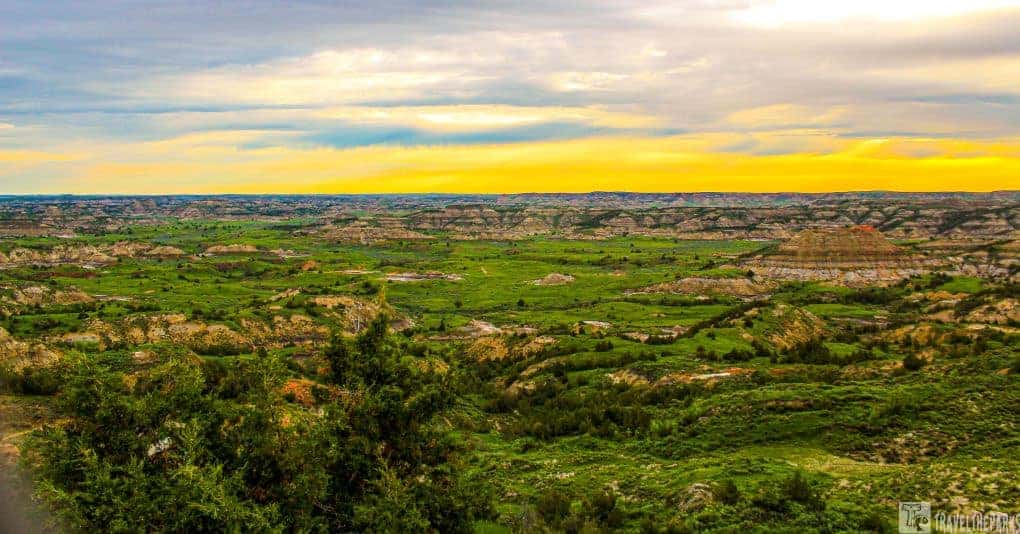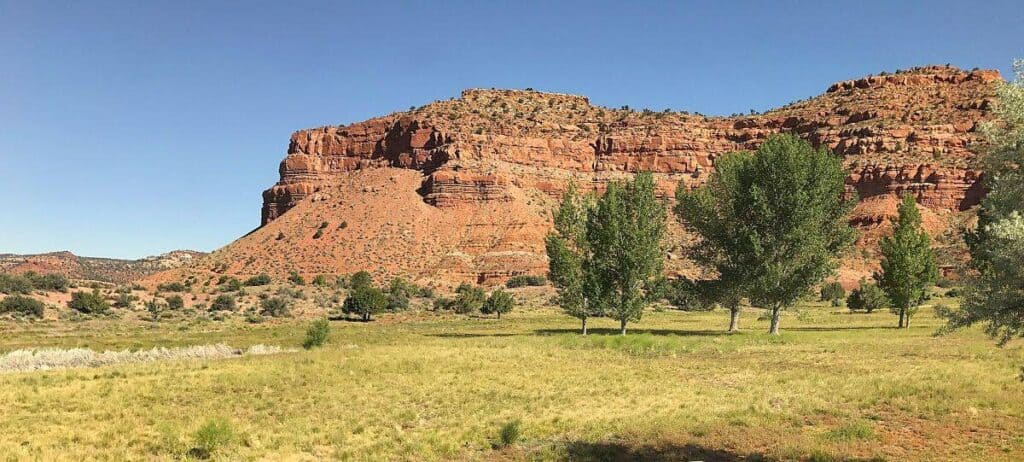Guest Post: Author Robert Moreland-Founder of Trizily.com
Montana, a state known for its rugged landscapes and breathtaking beauty, is also home to some of the best fly fishing in the world. And at the heart of it all is Glacier National Park. This majestic wilderness area, located in the northwestern part of the state, boasts some of the most pristine and remote fishing streams in the country. In this article, we will explore the world of fly fishing in Glacier National Park, including the best fly fishing spots, how to choose the right reels and rods, the best baits, and provide some tips and advice for those looking to embark on a fishing adventure in this spectacular region.
This post may contain affiliate links, meaning if you purchase something through one of these links, we may earn a small commission at no extra cost to you! Read the full disclosure policy here.
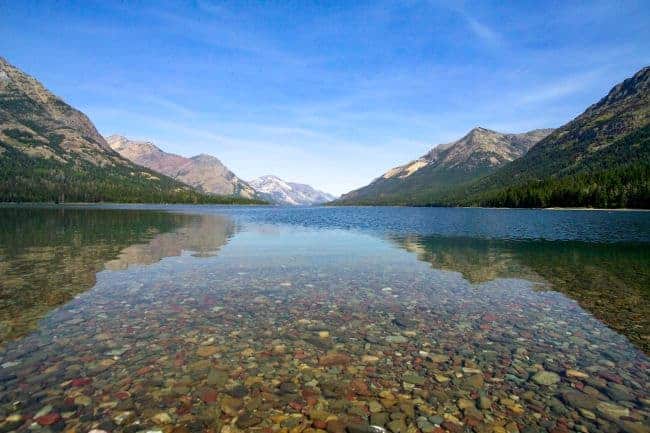
Table of Contents
A Basic Guide to Glacier National Park Fly Fishing
Fly fishing is a popular activity in Glacier National Park, and for good reason. The park is home to numerous lakes, rivers, and streams that offer a variety of fishing experiences. Whether you’re a seasoned angler or a beginner, Glacier National Park has something to offer.
Before you embark on your fishing adventure, it’s important to know a few basics about fly fishing in the park. First and foremost, you will need a fishing license. These can be obtained at various locations throughout the park, including the Apgar Visitor Center and the park’s entrance stations.
Once you have your license, you’ll need to decide where to fish. Glacier National Park has over 700 miles of streams and rivers, as well as more than 130 named lakes, so there are plenty of options to choose from. Some popular fishing spots include the Middle Fork of the Flathead River, which is known for its large cutthroat trout, and Bowman Lake, which offers stunning views of the surrounding mountains.

Best Fishing Spots in Glacier National Park
Fishing is a popular activity in Glacier National Park. The park is home to an abundance of lakes, streams, and rivers that provide great fishing opportunities. The fish in the park include brook trout, rainbow trout, brown trout, cutthroat trout, and bull trout.
Anglers can catch rainbow, brown, and brook trout on most of the park’s lakes and streams. In addition to the fish listed above, anglers also commonly catch lake trout and bull trout in Glacier National Park’s lakes. Most lakes have designated areas where you can catch these species.

There are many great fishing spots, but here is the best trout fishing in Glacier National Park:
1. Middle Fork of the Flathead River: The Middle Fork of the Flathead River is one of the most popular fishing spots in Glacier National Park, and for good reason. This river is home to large populations of cutthroat and rainbow trout, making it a great place to catch fish. The river is also surrounded by stunning scenery, with views of towering mountains and pristine wilderness.
2. Belly River: The Belly River is another popular spot for fly fishing in Glacier National Park. This river is known for its clear water and abundant fish populations, including cutthroat and rainbow trout. The Belly River is also home to some of the park’s most beautiful scenery, with views of the Rocky Mountains and the surrounding wilderness.

3. McDonald Creek: McDonald Creek is a small stream that flows through Glacier National Park. Despite its size, this stream is home to a variety of fish species, including cutthroat and rainbow trout. McDonald Creek is also an excellent place to fish for bull trout, a rare and highly prized catch.
4. Two Medicine River: The Two Medicine River is a scenic river that flows through the southeastern part of Glacier National Park. This river is home to cutthroat and rainbow trout, and is a great place to fish for those looking for a quieter fishing experience. The surrounding landscape of the Two Medicine River includes stunning views of nearby mountains and wilderness.

Types of Fish in Glacier National Park
Glacier National Park is home to a wide variety of fish species. The most common species found in the park include rainbow trout, cutthroat trout, brook trout, and bull trout.
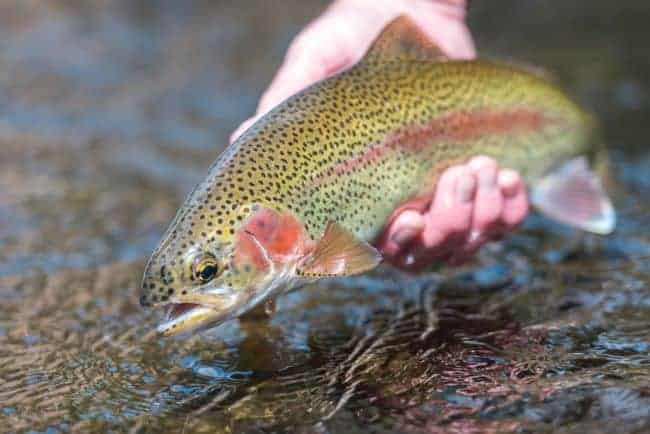
Rainbow Trout
Rainbow trout are the most abundant fish species found in Glacier National Park. They can be found in most of the park’s streams and rivers, as well as in many of the lakes and ponds. Rainbow trout are known for their acrobatic jumps and are a popular game fish among fly fishermen.

Cutthroat Trout
In the park, cutthroat trout are commonly found. They are easily identified by the distinctive red slashes under their lower jaw. Cutthroat trout can be found in many of the park’s streams and rivers, but are most commonly found in the higher elevations.

Brook Trout
Another prevalent species in Glacier National Park is brook trout. They can be found in many of the park’s streams and rivers, as well as in some of the high-elevation lakes and ponds. Brook trout are known for their colorful markings and are a popular game fish among fly fishermen.

Bull Trout
One species that is less prevalent in the park is the bull trout. They are primarily found in the park’s larger streams and rivers and are known for their aggressive behavior. These species are a protected species and must be released if caught.

Tips for fly fishing in Glacier National Park: Choosing the Best Bait
The first thing to consider when planning a fly fishing trip to Glacier National Park is the type of bait you’ll use. There are many different types of flies that you can use, but the best bait will depend on the time of year and the specific streams or rivers you plan to fish.
One of the most popular types of bait for fly fishing in Glacier is the dry fly. These are flies that float on the surface of the water and are designed to mimic the insects that fish feed on. Dry flies are typically used during the summer months, when insects are most active, and can be very effective in attracting trout.

Another popular type of bait is the nymph. Nymphs are flies that mimic the immature stage of aquatic insects, and they are often fished below the surface of the water. Nymphs are particularly effective in early spring and late fall, when insect activity is low.
Finally, streamers are another type of bait that can be effective in Glacier National Park. Streamers are larger flies that mimic baitfish, and they are often used to attract larger trout that are looking for a bigger meal.
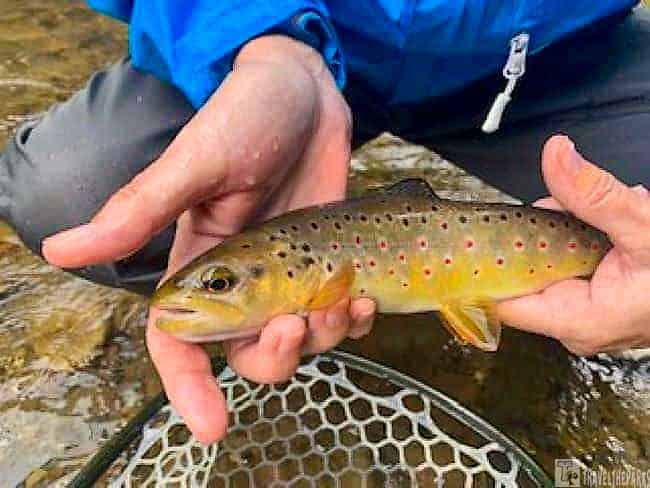
Choosing the Right Fly Fishing Gear for Glacier National Park
Before heading out to Glacier National Park for fly fishing, it’s essential to choose the right fishing gear and pack accordingly. In this, we’ll discuss how to select the right fishing gear for the trip.
Fly Rod
The first thing to consider when choosing fly fishing gear is the fly rod. The size of the rod depends on the type of fish you’ll be targeting and the size of the water you’ll be fishing in. For Glacier National Park, a 9-foot, 5-weight fly rod is the most versatile option. It’s suitable for catching trout in rivers, streams, and small lakes.
Fly Reel
A fly reel is the next essential piece of gear. It’s important to ensure that the size of the fishing reel is appropriate for the size of the fishing rod being used. For a 5-weight rod, a reel with a 5-weight line capacity is ideal. The reel should also have a smooth drag system to help tire out the fish and prevent the line from breaking.

Fly Line
Fly line is the next critical component. A weight-forward floating line is perfect for most fishing conditions in Glacier National Park. A floating line allows the angler to cast long distances and control the drift of the fly.
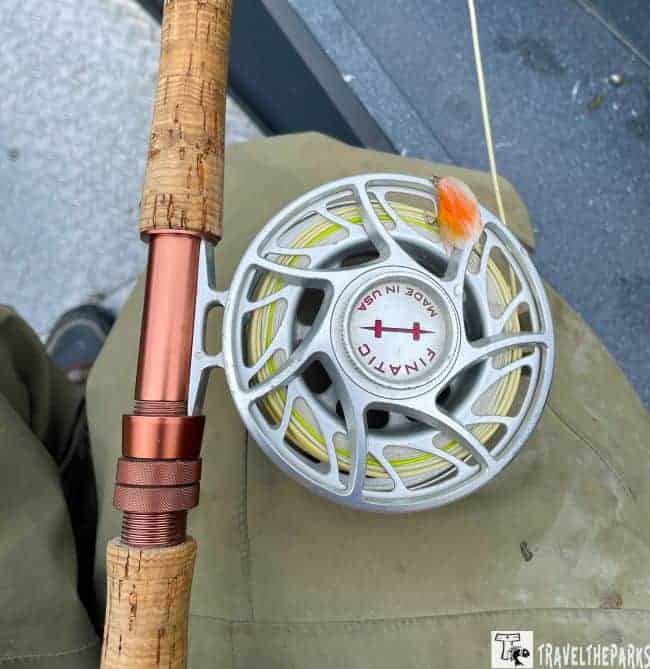
Leaders and Tippet
Leaders and tippets are essential for presenting the fly to the fish. A 9-foot tapered leader with a 4X or 5X tippet is suitable for most conditions in Glacier National Park. A longer leader may be necessary for clear water or spooky fish.

Flies
Flies are the final component of the gear. When it comes to choosing flies, there are two kinds of flies you can use: wet flies and dry flies. Wet flies are used for fishing in lakes and streams where there might be some water movement but not much current or flow, whereas dry flies are used for fishing in rivers with strong currents or water flows.
The type of fly will depend on the species of fish you’ll be targeting and the time of year. Some popular fly patterns for trout in Glacier National Park include dry flies, nymphs, and streamers. Be sure to pack a variety of patterns and sizes to increase your chances of catching fish.
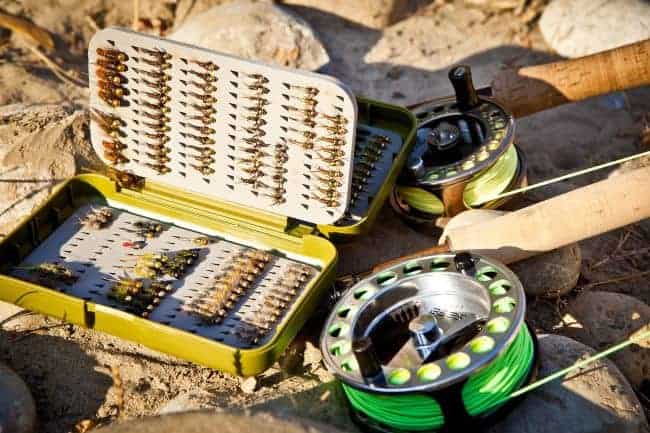
What Gear to Prepare for the Trip to Glacier National Park?
When you arrive at your fishing destination, it’s time to do some research. It’s important to know what kind of fish are available and how they behave in this particular location. For example, if you’re going to be looking for brook trout, it’s also important to know that they generally prefer slow-moving currents over fast-moving ones. The same goes for other species, such as trout and char.
Once you know what type of fishing you want to do, it’s time to look into gear options. If you plan on fishing from land or water, you’ll need a fly rod with a line spooled onto it and an appropriate line size. Most anglers will have a fly rod (or two) and reel on hand when they head out on the water. You can purchase your line at any sporting goods store or fly shop.

In addition to the above essentials, if you’re going on a fly-fishing trip in beautiful Glacier National Park, here are the other things you will need:
Waders and Wading Boots
Waders and wading boots are essential for fishing in Glacier National Park. The water can be cold, and waders will keep you warm and dry. Wading boots will provide traction on slippery rocks and make it easier to navigate through the water.

Fishing Vest or Pack
A fishing vest or pack is necessary to keep all your gear organized and easily accessible. A vest allows you to keep everything within reach, while a pack can carry more gear and provide more storage options.

Polarized Sunglasses
Polarized sunglasses are crucial for fly fishing. They reduce glare on the water, allowing the angler to see the fish and detect strikes more easily. They also protect the eyes from harmful UV rays.
Sunscreen and Bug Spray
The sun can be intense in Glacier National Park, and insect bites can be annoying. Be sure to pack sunscreen and bug spray to protect yourself from the sun and insects.
Water and Snacks
It’s essential to stay hydrated while fishing, so be sure to bring plenty of water. Snacks such as granola bars or trail mix will provide energy to keep you going throughout the day.
Best Time to Go for Fly Fishing in Glacier National Park
The best time to go fly fishing in Glacier National Park is from June through September. During this time, the water levels are at their lowest, making it easier to access the streams and rivers. Additionally, the weather is mild, with daytime temperatures ranging from the mid-60s to the low 80s, and nighttime temperatures in the 40s and 50s.
June and July are the best months for dry fly fishing, as the hatches of caddisflies and mayflies are at their peak. August and September are better for nymph fishing, as the water temperatures are cooler and the fish are more active. In general, the best time of day to fish is in the morning and late afternoon, as the fish are more active during these times.

Tips for Fly Fishing in Glacier National Park
Fly-fishing in Glacier National Park is a great way to experience the beauty and majesty of the park. It’s also a fun way to spend time together as a family or with friends. As one of the few national parks that allows fly fishing, Glacier is a great place to learn how to cast a line and catch your own food.
Fly fishing in Glacier is also a great option for families with small children. The park offers many areas that can be accessed by car or on foot, making it easy for people of all ages to enjoy this outdoor activity.
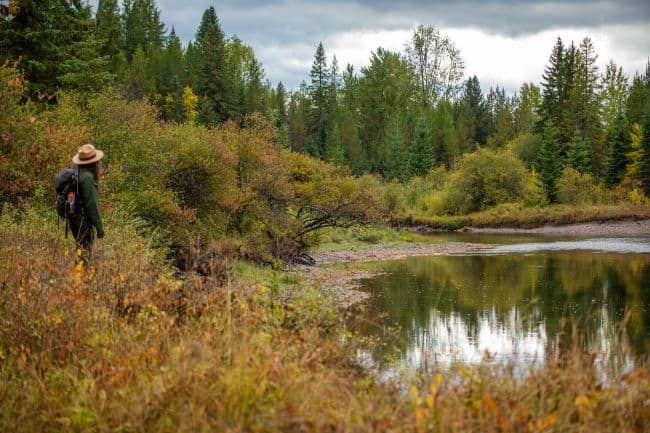
Here are some tips for fly fishing in Glacier National Park:
Know the regulations
Before you start fly fishing in Glacier National Park, it’s important to familiarize yourself with the regulations. These regulations include restrictions on the types of flies you can use, the size of the fish you can keep, and the areas where fishing is prohibited. It’s important to follow these regulations to protect the park’s delicate ecosystem and ensure that the fish population remains healthy.

Choose the right gear
When it comes to fly fishing gear, there are a few essentials that you’ll need. These include a fly rod, reel, and line, as well as waders and boots. It’s important to choose gear that is appropriate for the type of fishing you’ll be doing and the conditions you’ll be fishing in. For example, if you’ll be fishing in a small stream, a shorter rod may be more effective than a longer one.
Bring the right flies
Choosing the right flies is essential for successful fly fishing in Glacier National Park. The type of fly you choose will depend on the season, the time of day, and the type of water you’ll be fishing in. Some popular flies for Glacier National Park include the Elk Hair Caddis, the Adams, and the Royal Wulff.
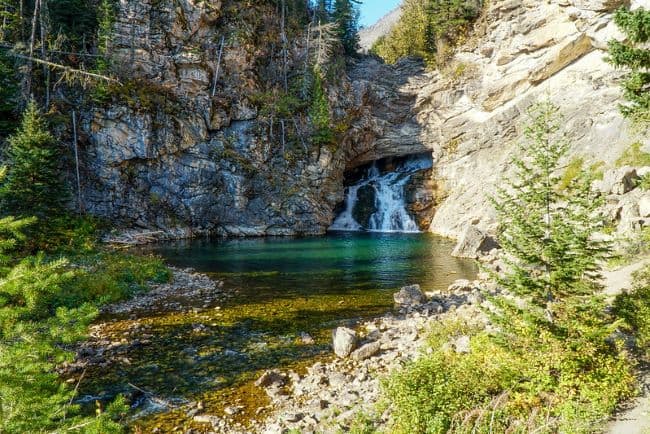
Pay attention to the weather
The weather can have a big impact on fly fishing in Glacier National Park. In general, the best time to fish is during the summer months when the water is warmer and the fish are more active. However, it’s important to keep an eye on the weather forecast and adjust your plans accordingly. For example, if there’s a storm coming, it may be best to avoid fishing on open water.
Look for the right spots
Glacier National Park is home to a variety of lakes and streams that are ideal for fly fishing. Some popular spots include Bowman Lake, Lake McDonald, and the Middle Fork of the Flathead River. When choosing a spot to fish, it’s important to look for areas where the water is deep enough for fish to swim, and where there is plenty of cover for the fish to hide.
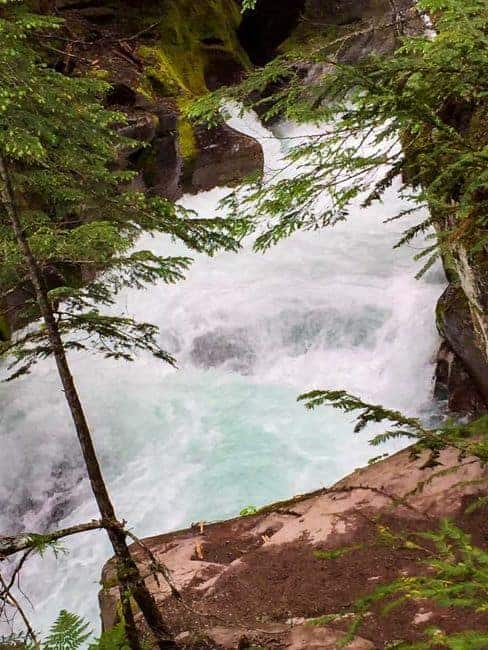
Practice catch and release
Glacier National Park is home to some of the most beautiful and pristine waterways in the country. To protect these delicate ecosystems, it’s important to practice catch and release whenever possible. This means releasing the fish back into the water after you’ve caught them, rather than keeping them to eat.
Be respectful of wildlife
Within Glacier National Park, there is a diverse array of wildlife that can be found, such as grizzly bears, black bears, and mountain lions. When fly fishing in the park, it’s important to be respectful of these animals and take steps to avoid disturbing them. This may include making noise as you move through the area, carrying bear spray, and avoiding fishing in areas where wildlife is known to be active.
Hire a Guide
If you’re new to fly fishing or unfamiliar with the area, it’s a good idea to hire a guide. For us, I know that our previous trips to Yellowstone’s Madison River, Black Hills in the Dakotas, Colorados trout streams and Alaska Rivers having a guide has been essential. A guide can provide valuable information about the best fishing spots, the type of gear to use, and the local fishing regulations. They can also help you improve your casting technique and increase your chances of catching fish.
Fishing Regulations in Glacier National Park
Before embarking on a fishing trip in Glacier National Park, it is essential to familiarize yourself with the fishing regulations. The park has strict rules in place to protect fish populations and their habitats. These regulations include:
- Fishing License: Anyone aged 16 or older who plans to fish in the park must have a valid Montana fishing license. These licenses are available from Montana Fish, Wildlife, and Parks, and can be purchased online or from a licensed dealer. The park also issues special permits for commercial fishing guides and outfitters.
- Fishing Seasons: The fishing season in Glacier National Park typically runs from the third Saturday in May to November 30th. However, some streams and rivers have different fishing seasons. It is important to check the specific fishing regulations for the area you plan to fish.
- Fishing Methods: Only fly fishing and hand-held lines are allowed in Glacier National Park. The use of bait or lures is prohibited. Additionally, all fish must be caught and released unharmed, except for brook trout, which can be harvested with a daily limit of 10 fish.
- Fishing Areas: Fishing is prohibited in some areas of the park, including Swiftcurrent Lake, Lake McDonald, and the North Fork of the Flathead River. It is important to check the park’s fishing regulations for the specific area you plan to fish.
- Fish Species: Glacier National Park is home to a variety of fish species, including cutthroat trout, rainbow trout, bull trout, and brook trout. However, like Yellowstone or other national parks some species are protected, and their harvest is prohibited. It is important to identify the fish species and their regulations before fishing.
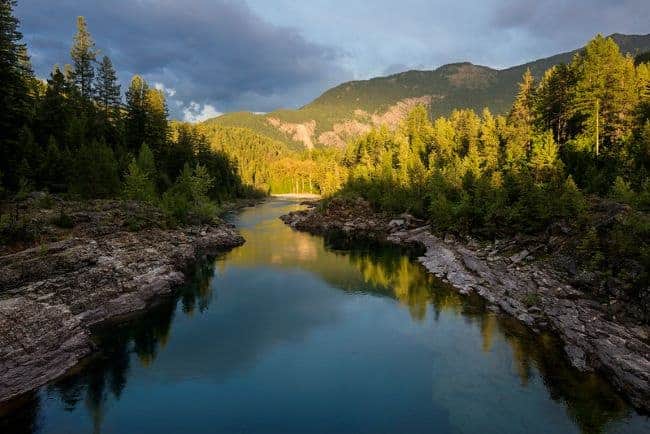
Final Thoughts on Fly Fishing Glacier National Park
In conclusion, fly fishing in Glacier National Park, Montana, is an unparalleled experience for avid anglers and nature enthusiasts alike. With its pristine waters, stunning scenery, and diverse fish species, Glacier National Park offers a unique fly fishing adventure that is both challenging and rewarding. However, it is important to note that fly fishing in the park requires strict adherence to conservation guidelines, including catch-and-release practices and respecting the natural environment. With the proper preparation and knowledge of local regulations, visitors can enjoy a truly unforgettable fly fishing experience in one of the most breathtaking national parks in the United States.
If you have fished in Glacier National Park, what was your favorite moment? Tell us your story in the comments below.

